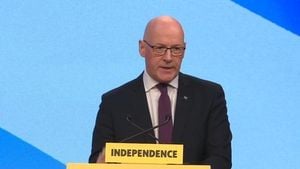Gold and oil markets saw notable shifts on August 23, 2025, as investors digested signals from the U.S. Federal Reserve and ongoing global economic uncertainties. Gold prices in Vietnam and globally responded to expectations that the Federal Reserve (Fed) might lower interest rates in September, while oil prices edged higher amid supply concerns and geopolitical tensions.
Domestically, gold prices held steady at high levels. According to reports from multiple Vietnamese sources, at 4:30 AM on August 23, SJC gold bars were listed at 124.4-125.4 million VND per tael by major retailers including Saigon Jewelry Company, Bao Tin Minh Chau, and DOJI. This price was unchanged from the previous session, with a buying-selling spread of 1 million VND. At Phu Quy, SJC gold traded at 123.4-125.4 million VND per tael, also stable compared to the prior day. Mi Hong reported SJC gold at 124.9-125.4 million VND per tael, again reflecting no change.
Gold rings, which are another popular investment form in Vietnam, saw modest increases. DOJI listed 9999 gold rings at 117.4-120.4 million VND per tael, up 100,000 VND from the previous day. Bao Tin Minh Chau’s 9999 gold rings were priced at 117.6-120.6 million VND per tael, also increasing by 100,000 VND. SJC’s gold rings were bought at 117.5 million VND per tael and sold at 120 million VND, marking a 200,000 VND rise in both directions. PNJ’s gold rings were traded at 117.5-120.5 million VND per tael, up 200,000 VND. Phu Quy’s gold rings, however, dipped by 100,000 VND to 117.2-120.2 million VND per tael.
Globally, the gold market was influenced by monetary policy expectations and currency movements. At 4:30 AM, Kitco reported spot gold at 3,373.39 USD per ounce, a slight 0.07% decrease from the previous day. Just under two hours later, the price ticked up to 3,372.64 USD per ounce, a 1.02% increase over the previous 24 hours. When converted using the free market exchange rate of 26,563 VND per USD, this amounted to roughly 108 million VND per tael, not accounting for taxes or fees. This left domestic SJC gold bars priced about 17.4 million VND higher per tael than their international equivalent, a gap reflecting local market dynamics and regulatory factors.
The U.S. dollar’s recent weakness contributed to gold’s appeal. Reuters noted that the dollar lost 0.7% against other major currencies, making gold more affordable for non-dollar holders. This currency shift came on the heels of a pivotal speech by Fed Chairman Jerome Powell at the Jackson Hole conference. Powell acknowledged mounting risks to both the labor market and inflation, yet he avoided making a firm commitment on the timing of potential rate cuts. As he put it, “The change in the balance of risks could force the Fed to adjust policy, but we must avoid making any firm promises about rate cuts.”
Market expectations for a rate cut surged following Powell’s remarks. The CME’s FedWatch tool showed a 90% probability that the Fed would reduce rates by 25 basis points in September, up sharply from 75% before his speech. Powell also stressed that upcoming employment and inflation data, due before the Fed’s September 16-17 policy meeting, would be crucial in shaping the central bank’s decision. Historically, gold tends to perform well in low-interest environments, since it doesn’t yield interest and becomes more attractive relative to other assets.
Despite the global spotlight, physical gold demand in Asia remained subdued. According to Kitco and other sources, price volatility kept buyers cautious, though Indian jewelers began restocking in anticipation of the festival season. Meanwhile, other precious metals saw gains: silver rose 1.3% to 38.67 USD per ounce, platinum climbed 0.5% to 1,359.75 USD, and palladium increased 1.4% to 1,126.25 USD.
Turning to energy markets, global crude oil prices inched up. Oilprice reported Brent crude rising by 0.15 USD per barrel (0.22%) to 67.82 USD, while West Texas Intermediate (WTI) climbed 0.25 USD per barrel (0.39%) to 63.77 USD. Both benchmarks had gained over 1% in the previous session, closing the week up 2.9% (Brent) and 1.4% (WTI).
Several factors underpinned oil’s resilience. The U.S. Energy Information Administration (EIA) revealed that American crude inventories dropped by 6 million barrels in the prior week, far exceeding analysts’ expectations of a 1.8 million barrel draw. This pointed to robust demand. Additionally, the number of active U.S. oil and gas rigs fell to 538—the lowest since mid-July—marking the fourth decline in five weeks, as reported by Baker Hughes. Fewer rigs typically signal tighter future supply.
Geopolitical developments also played a role. UBS analyst Giovanni Staunovo observed, “Everyone is waiting for the next move from U.S. President Donald Trump. In the coming days, it seems nothing will happen.” Trump himself commented on the ongoing Russia-Ukraine conflict, saying he would “see if President Putin and President Zelensky can work together to end the conflict.” Yet, as Price Futures Group’s Phil Flynn noted, “There is still uncertainty surrounding the possibility of a ceasefire, and negotiations are not progressing as quickly as the market had hoped.” ING analysts warned that a lower likelihood of a ceasefire could prompt the U.S. to impose tougher sanctions on Russia, potentially impacting supply.
In Europe, economic worries lingered after German data showed a 0.3% contraction in GDP for the second quarter of 2025, raising concerns about future oil demand. Market participants also kept a close eye on the Jackson Hole symposium, anticipating how U.S. monetary policy might affect global growth and, by extension, energy consumption. Powell’s acknowledgment of labor market and inflation risks, though without a concrete pledge to cut rates, left markets guessing. Still, lower rates could stimulate economic activity and boost oil demand, potentially driving prices higher.
Vietnam’s domestic fuel prices reflected global trends. On August 23, retail prices were capped as follows: E5RON92 gasoline at 19,464 VND per liter, RON95-III at 20,092 VND, diesel 0.05S at 17,905 VND, kerosene at 17,814 VND, and mazut at 15,116 VND per kilogram. The Ministry of Industry and Trade and Ministry of Finance had adjusted prices on August 21, raising gasoline by 110-208 VND per liter, but lowering diesel, kerosene, and mazut by 152-206 VND per unit. Notably, the ministries opted not to use the fuel price stabilization fund during this round.
Global oil price movements were shaped by U.S. inventory shifts, ongoing discussions between American, Russian, and Ukrainian leaders regarding the Ukraine conflict, and persistent military tensions in the region. These factors kept oil prices volatile, with direction varying by product.
As August draws to a close, investors and policymakers alike are watching the interplay between central bank decisions, economic data, and geopolitical events. The coming weeks may determine whether gold can break through the 3,400 USD barrier and whether oil’s upward momentum will persist, all against a backdrop of shifting global risks and opportunities.




